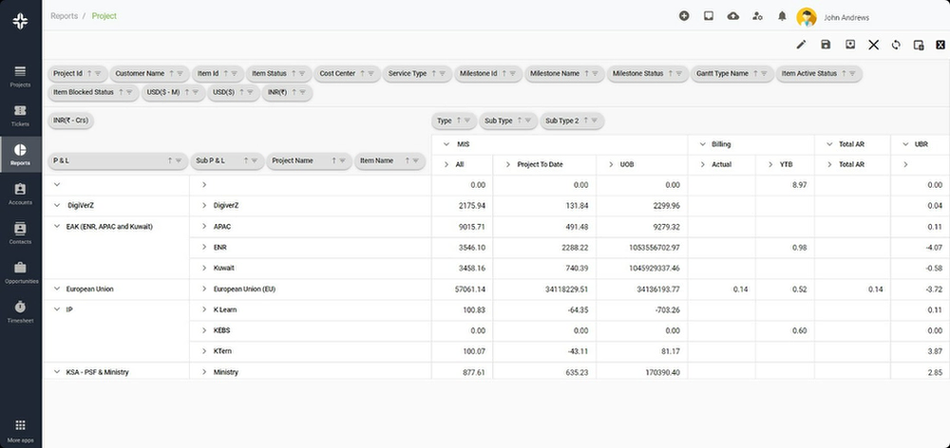
Home »
Understanding Resource Management in Professional Services Automation
Learn how to maximize project productivity and success through strategic resource allocation.
Introduction to Professional Services Automation
Professional Services Automation (PSA) refers to a software solution designed to streamline and automate various aspects of professional service organizations. Whether it is a consulting firm, an IT services company, or a marketing agency, PSA systems help optimize business processes, enhance project management and improve overall operational efficiency.
PSA software typically integrates multiple functionalities into a unified platform, providing a comprehensive suite of tools for managing projects, resources, time, expenses, and billing. It acts as a central hub, facilitating collaboration and communication among team members, clients, and stakeholders.PSA systems offer resource management capabilities, enabling businesses to optimize resource allocation based on skills, availability, and workload. This helps prevent resource over- or under-utilization, maximizing productivity and profitability.
Overall, Professional Services Automation (PSA) solutions enable professional service organizations to streamline their operations, enhance project delivery, and optimize resource utilization, ultimately driving increased efficiency, client satisfaction, and profitability.
What is Professional Services Resource Management?
Professional Services Resource Management (PSRM) refers to the process of effectively allocating, managing, and optimizing resources within a professional service organization. It involves strategically aligning the right resources with the right projects and tasks to maximize productivity, efficiency, and profitability.
PSRM encompasses various aspects of resource management, including skills tracking, capacity planning, resource allocation, and scheduling. By gaining a clear understanding of the skills and expertise of the resources available within the organization, PSRM enables businesses to match the right people to the right projects or engagements.
Why is Professional Services Resource Management Important?
Professional Services Resource Management is crucial for professional service organizations for several reasons:
- Optimal Resource Utilization: It helps organizations effectively allocate their resources based on skills, availability, and workload.
- Enhanced Project Delivery: Proper resource management is essential for successful project execution. PSRM allows businesses to identify resource gaps, allocate resources strategically, and avoid overburdening individuals or teams.
- Improved Profitability: Effective resource management enables organizations to optimize their resource utilization and minimize resource wastage.
- Client Satisfaction: Well-managed resources ensure that projects are executed with the right expertise and within the agreed timelines.
- Talent Retention and Development: By effectively managing resources, organizations can identify skill gaps and invest in training or hiring initiatives to bridge those gaps.
Scalability and Growth: It provides organizations with a clear view of their resource capacity and availability. This enables them to make informed decisions regarding resource allocation and plan for future growth.

Key Components of Resource Management in PSA
Resource Planning: Resource planning entails assessing project requirements, estimating the type and quantity of resources needed, and aligning them with the project timeline.
- Resource Allocation: Once resource planning is done, the next step is allocating the right resources to specific projects or tasks. Resource allocation involves assigning individuals or teams based on their skills, availability, and workload.
- Capacity Management: Capacity management focuses on evaluating the workload and capacity of resources within the organization. It involves assessing the availability and capability of resources to take on additional work or projects.
- Skills Management: Skills management involves tracking and managing the skills and expertise of resources within the organization. It helps in identifying the strengths and capabilities of individual resources, allowing for better resource allocation based on specific project requirements.
- Resource Scheduling: Resource scheduling involves creating and managing project timelines and allocating resources to specific time slots. It ensures that resources are assigned to projects in a way that minimizes conflicts and optimizes their availability.
- Resource Tracking and Reporting: This component involves monitoring and tracking the utilization and performance of resources. It includes capturing data such as time entries, expenses, and project progress. Resource tracking and reporting provide insights into resource utilization, project profitability, and overall operational efficiency.

Benefits of Integrating Professional Services Resource Management Software
Integrating Professional Services Resource Management software into an organization brings numerous benefits, including:
- Increased productivity and efficiency.
- Reduced resource conflicts and bottlenecks.
- Better visibility into resource availability and capacity.
- Streamlined resource planning and forecasting.
- More accurate project costing and budgeting.
- Effective skills tracking and utilization.
- Simplified resource scheduling and assignment.
- Improved collaboration and communication among teams.
- Enhanced decision-making through data-driven insights.
- Efficient tracking of time, expenses, and project progress.
- Enhanced client satisfaction through timely and quality project delivery.
Overall, integrating Professional Services Resource Management software enables organizations to optimize their resource management practices, improve project outcomes, maximize profitability, and drive operational excellence in professional service delivery.
| Benefits of Integrating Resource Management Software | Advantages |
|---|---|
| Increased Productivity and Efficiency | Boosted operational output and streamlined processes. |
| Reduced Resource Conflicts and Bottlenecks | Minimized clashes and smoother workflow progression. |
| Better Visibility into Resource Availability and Capacity | Clear insight for optimal resource utilization and allocation. |
| Streamlined Resource Planning and Forecasting | Efficient planning for current and future project needs. |
| More Accurate Project Costing and Budgeting | Precise financial estimates for improved project management. |
| Effective Skills Tracking and Utilization | Optimized talent deployment based on skillsets. |
| Simplified Resource Scheduling and Assignment | Effortless task allocation and progress tracking. |
| Improved Collaboration and Communication | Enhanced teamwork and seamless information flow. |
| Enhanced Decision-Making through Data-Driven Insights | Informed choices based on data analytics. |
| Efficient Tracking of Time, Expenses, and Project Progress | Accurate record-keeping and project monitoring. |
| Enhanced Client Satisfaction | Timely and high-quality project delivery for client delight. |
| Operational Excellence in Professional Service Delivery | Optimized practices for superior service outcomes. |
Challenges in Resource Management for PSAs
While Professional Services Automation (PSA) systems offer significant benefits for resource management, there are also some challenges that organizations may face. These challenges include:
- Resource Availability and Skills Gap: Finding the right resources with the required skills and availability can be a challenge. It may be difficult to match the specific expertise needed for certain projects or engagements, leading to resource shortages or skill gaps.
- Resource Allocation Conflicts: Managing multiple projects simultaneously can result in resource allocation conflicts. It can be challenging to prioritize and allocate resources effectively, especially when there are competing demands and dependencies across projects.
- Changing Project Priorities: Project priorities often shift due to client demands or changing business needs. This can disrupt resource allocation plans and require realignment of resources, posing a challenge in maintaining project continuity.
- Limited Resource Visibility: Lack of real-time visibility into resource availability, skills, and workload can hinder effective resource management. Organizations may struggle to make informed decisions without accurate and up-to-date information.
- Resource Communication and Collaboration: Effective communication and collaboration among resources are vital for successful project execution. Ensuring seamless coordination and information sharing can be challenging, especially when teams are dispersed or working remotely.
- Resource Tracking and Reporting: Accurately tracking resource time, expenses, and project progress can be a challenge. Incomplete or inaccurate data can impact project costing, profitability analysis, and decision-making.
- Integration with Other Systems: Integrating the PSA system with other tools, such as human resource management or project management software, can be complex. Ensuring data consistency and seamless information flow across systems may pose integration challenges.
- Change Management and Adoption: Implementing a new resource management system may require changes in processes and workflows. Organizational change management and user adoption can be challenging, requiring proper training and support to ensure successful implementation.
Best Practices for Resource Management in PSA
Conduct thorough resource planning and forecasting to anticipate project demands and align resource allocation accordingly.
Regularly assess resource availability, workload, and skills to identify gaps and proactively address them through hiring, training, or reallocation.Implement a centralized system for resource scheduling and assignment to optimize utilization and avoid conflicts or overburdening of resources.
Foster open communication and collaboration among team members and departments to facilitate resource sharing and knowledge exchange.Continuously track and analyze resource data, such as time entries and project progress, to make data-driven decisions and identify areas for improvement in resource management.

Technology and Tools for Professional Services Resource Management
PSA Software
PSA software enables organizations to create resource profiles for employees and contractors, including their skills, availability, and workload. It provides a comprehensive view of the resource pool, allowing managers to easily identify and assign the right resources to specific projects or tasks. Additionally, PSA software often includes capabilities for managing resource calendars, tracking time and attendance, and monitoring resource utilization to ensure optimal resource allocation.
Resource Management Tools
Resource management tools enable organizations to analyze their resource requirements, identify gaps or overloads, and make informed decisions about resource allocation. They provide insights into resource utilization patterns, skill gaps, and productivity metrics, helping organizations optimize their resource allocation strategies and make data-driven resource planning decisions.
Integration with Project Management Systems
Integration between PSA software, resource management tools, and project management systems ensures data consistency and reduces the need for manual data entry. It streamlines workflows, enhances collaboration between project managers and resource managers, and provides a holistic view of project and resource data across the organization.

Examples of Effective Professional Services Resource Management
KEBS: Effective Professional Services Resource Management Software

KEBS resource management
- Employee Onboarding : A completely digitized process to ensure swift onboarding of employees
- Travel management : Develop comprehensive and budget-friendly travel plans for your employees.
- Performance Management System : Set precise goals and align the objectives of your organization with that of your resources
- Learning & Development : Upskill your employees to unleash the fullest of their potential
- Recruitment (ATS) : Scout for the best talents without breaking a sweat.
- Expense claims & advance process : Save ample time and energy with an automated claim reimbursement process
- Timesheet : Replace excessive paperwork with an automated leave tracker & approver
- Payroll management : Automate the payroll operations for timely pay-outs without delays
- People management : Manage your resources efficiently to ensure maximum productivity
- Leave Application : Approve or decline leave requests instantly.
- Employee 360 : Fetch A-Z employee data in just a click. Get a comprehensive database of all your resources.
- Employee Exit : Customize a smooth exit process for your resignees.

Future Trends and Innovations in Resource Management
Artificial Intelligence (AI) and Machine Learning (ML) will play a significant role in optimizing resource management by analyzing data, predicting resource needs, and automating resource allocation processes. Increased adoption of cloud-based resource management solutions, enabling real-time access to resource information and facilitating remote collaboration.
Integration of resource management systems with project management and enterprise resource planning (ERP) systems for seamless data exchange and holistic resource visibility. Emphasis on skills and competency-based resource management, matching resources to projects based on specific skill requirements rather than generic job roles.
Use of advanced analytics and data-driven insights to identify trends, improve resource utilization, and make informed decisions in resource allocation. Agile resource management methodologies that promote flexibility, adaptability, and dynamic allocation of resources in response to changing project requirements.
| Advancements in Resource Management | Key Focus Areas |
|---|---|
| AI and Machine Learning | Leveraging data analysis, prediction, and automation. |
| Cloud-Based Solutions | Enabling real-time access, remote collaboration, and visibility. |
| Integration with Project Management and ERP | Enhancing data exchange and holistic insights. |
| Skills-Based Resource Allocation | Matching resources to specific skill requirements. |
| Data-Driven Insights | Utilizing analytics for trend identification and decision-making. |
| Agile Resource Management | Embracing flexibility and adaptability in allocation. |
Conclusion
In conclusion, resource management plays a critical role in the success of professional services organizations. With the help of Professional Services Automation (PSA) software like KEBS, businesses can streamline and optimize their resource allocation processes. PSA software enables effective planning, tracking, and utilization of resources, resulting in improved project outcomes, increased productivity, and enhanced client satisfaction.
By adopting resource management strategies such as centralized resources, real-time allocation, skill-based matching, and agile methodologies, organizations can ensure that the right resources are assigned to the right projects at the right time. Integration with project management systems and other modules further enhances visibility, collaboration, and data consistency.
Take your organization to the next level!









